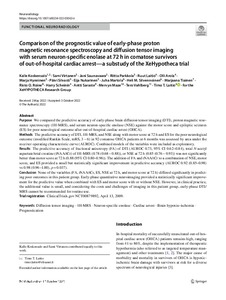Comparison of the prognostic value of early-phase proton magnetic resonance spectroscopy and diffusion tensor imaging with serum neuron-specific enolase at 72 h in comatose survivors of out-of-hospital cardiac arrest-a substudy of the XeHypotheca trial
Koskensalo Kalle; Virtanen Sami; Saunavaara Jani; Parkkola Riitta; Laitio Ruut; Arola Olli; Hynninen Marja; Silvasti Päivi; Nukarinen Eija; Martola Juha; Silvennoinen Heli M; Tiainen Marjaana; Roine Risto O; Scheinin Harry; Saraste Antti; Maze Mervyn; Vahlberg Tero; Laitio Timo T; XeHYPOTHECA Research Group
https://urn.fi/URN:NBN:fi-fe2022121772434
Tiivistelmä
Purpose: We compared the predictive accuracy of early-phase brain diffusion tensor imaging (DTI), proton magnetic resonance spectroscopy (1H-MRS), and serum neuron-specific enolase (NSE) against the motor score and epileptic seizures (ES) for poor neurological outcome after out-of-hospital cardiac arrest (OHCA).
Methods: The predictive accuracy of DTI, 1H-MRS, and NSE along with motor score at 72 h and ES for the poor neurological outcome (modified Rankin Scale, mRS, 3 - 6) in 92 comatose OHCA patients at 6 months was assessed by area under the receiver operating characteristic curve (AUROC). Combined models of the variables were included as exploratory.
Results: The predictive accuracy of fractional anisotropy (FA) of DTI (AUROC 0.73, 95% CI 0.62-0.84), total N-acetyl aspartate/total creatine (tNAA/tCr) of 1H-MRS (0.78 (0.68 - 0.88)), or NSE at 72 h (0.85 (0.76 - 0.93)) was not significantly better than motor score at 72 h (0.88 (95% CI 0.80-0.96)). The addition of FA and tNAA/tCr to a combination of NSE, motor score, and ES provided a small but statistically significant improvement in predictive accuracy (AUROC 0.92 (0.85-0.98) vs 0.98 (0.96-1.00), p = 0.037).
Conclusion: None of the variables (FA, tNAA/tCr, ES, NSE at 72 h, and motor score at 72 h) differed significantly in predicting poor outcomes in this patient group. Early-phase quantitative neuroimaging provided a statistically significant improvement for the predictive value when combined with ES and motor score with or without NSE. However, in clinical practice, the additional value is small, and considering the costs and challenges of imaging in this patient group, early-phase DTI/MRS cannot be recommended for routine use.
Kokoelmat
- Rinnakkaistallenteet [27094]
